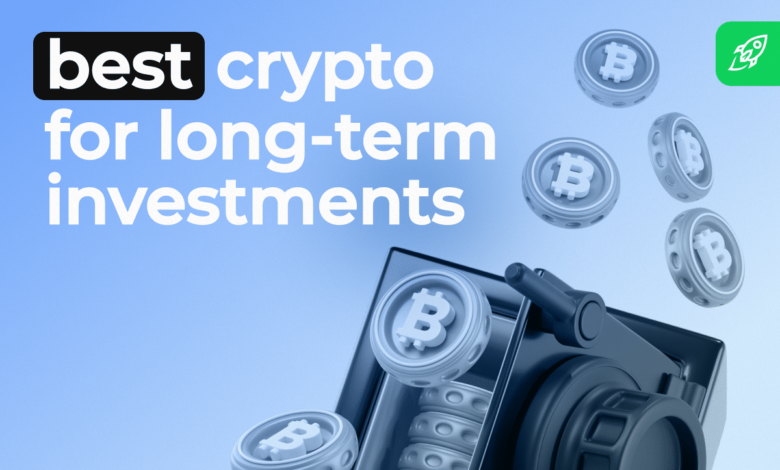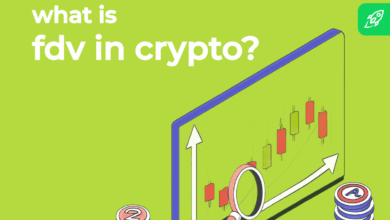Best Long-Term Cryptocurrencies for 2024 – Cryptocurrency News & Trading Tips – Crypto Blog by Changelly

Cryptocurrency has come a long way since the advent of Bitcoin in 2009. With numerous digital coins flooding the market, investors are left wondering which ones will stand the test of time and prove to be the best long-term investments.
Hello! My name is Zifa, and I’m a passionate cryptocurrency enthusiast. For the past three years, I’ve dedicated myself to exploring and writing about the ever-evolving world of crypto. My journey has taken me through the highs and lows of the market, equipping me with insights and perspectives on what makes a cryptocurrency stand out in the long haul. As we turn our gaze towards 2024, I’m excited to share my picks for the best long-term crypto investments.
What Are the Best Long-Term Cryptocurrencies?
The future of cryptocurrencies remains uncertain but exciting. While some coins might fade away, others will likely emerge as winners in the long run. By carefully reviewing the fundamentals, technological advancements, and market trends, we identified the best long-term cryptocurrencies that have the potential to shape the financial landscape in the years to come.
Bitcoin (BTC)
Bitcoin is often regarded as digital gold due to its decentralized nature and the significant attention it has garnered over the years. A pivotal factor contributing to its esteemed value lies in its limited supply. Unlike traditional fiat currencies, which central banks can issue without limit, Bitcoin’s supply is strictly capped at 21 million coins. This scarcity principle positions Bitcoin as a highly valuable asset, especially as demand increases while the supply remains unchanged.
As a pioneer in the cryptocurrency space, Bitcoin has solidified its status as a trusted digital currency. Its backbone, the blockchain technology, offers unparalleled transparency and security for transactions. The permanence of each transaction on the blockchain eradicates the necessity for intermediaries, fostering deeper trust among participants. This trait, coupled with Bitcoin’s decentralized framework, renders it an attractive option for entities and individuals in pursuit of a secure and streamlined medium for financial dealings.
The mainstream acceptance of Bitcoin is further underscored by the endorsement of Bitcoin exchange-traded funds (ETFs) and their robust performance in the initial months of 2024. ETFs represent investment avenues that provide Bitcoin exposure to both institutional and retail investors. The sanctioning and introduction of Bitcoin ETFs signify a growing acknowledgment of Bitcoin as a legitimate investment class by regulatory bodies and institutional entities. Additionally, Bitcoin’s resilience and notable performance early in 2024 have drawn increased interest, solidifying its acceptance in the mainstream.
Reflecting its significance, Bitcoin’s market capitalization—a metric derived by multiplying the current price of Bitcoin by its total circulating supply—has escalated to unprecedented levels, reaching the multi-trillion-dollar mark. This surge emphasizes the vast value that investors and the market place on Bitcoin, making it arguably the best long-term crypto investment.
Ethereum (ETH)
Ethereum, established in 2014, has emerged as a pivotal player in the crypto space, particularly renowned for revolutionizing executing smart contracts, NFTs, and DeFi protocols. Its decentralized framework facilitates a broad spectrum of applications, notably in decentralized finance (DeFi), enabling users to undertake lending, trading, and other financial operations without traditional intermediaries.
Ethereum’s strategic importance extends to supporting Web3 technologies, advocating for a more decentralized internet. The platform’s integration of layer 2 solutions like Optimism and Arbitrum enhances transaction efficiency and affordability, broadening access to blockchain activities. Ethereum continues to lead in innovation, attracting developers and users keen on exploiting its capabilities for diverse projects and investments.
The Ethereum Virtual Machine (EVM) is a cornerstone feature, enabling the execution of smart contracts that operate automatically upon meeting set conditions, thus eliminating the need for intermediaries. This technological breakthrough underscores Ethereum’s vast growth potential, offering transparency and security across transactions. It’s an appealing choice for industries looking to harness decentralized applications (dApps) for transforming finance, supply chain management, and healthcare.
Moreover, Ethereum’s pivotal role in the gaming industry, where it facilitates the secure creation and trading of virtual assets, has spurred the development of blockchain-based games. These innovations provide players with unprecedented ownership and value for in-game assets, reinforcing Ethereum’s value and adoption across various sectors.
Solana (SOL)
Solana (SOL), with its innovative blend of proof-of-stake and proof-of-history consensus mechanisms, has swiftly risen to prominence in the realm of crypto assets. This hybrid approach enables Solana to offer unparalleled scalability and speed in transactions, making it an attractive option for both developers and crypto investors. Its capability to support decentralized applications (dApps) through smart contracts, akin to Ethereum, yet with superior scalability, highlights its technological edge.
A standout feature of Solana is its impressive transaction capacity: the network can handle up to 50,000 transactions per second (TPS) at a minimal average cost of $0.00025 per transaction. This efficiency is a testament to its innovative consensus mechanism, but that’s not all. It also positions Solana as a cost-effective blockchain platform, significantly reducing trading fees for its users. The meteoric rise of its native token, SOL, from $1.8 in January 2021 to an all-time high of $260 in November emphasizes the market’s strong confidence and interest in Solana’s potential.
The launch of the Saga phone marks a pivotal development for Solana, integrating blockchain technology into a mobile device to offer users a seamless experience with decentralized applications. This advancement is a leap towards the widespread adoption of blockchain technology in everyday life.
Moreover, the migration of the Render Network to Solana’s blockchain further attests to Solana’s growing prestige and trust within the cryptocurrency community. Render’s choice reflects Solana’s appeal, thanks to its low fees, quick transaction confirmations, and robust infrastructure. These milestones exemplify not only Solana’s technological advancements but also its commitment to fostering a more accessible and decentralized digital world.
Avalanche (AVAX)
Avalanche stands out in the blockchain realm as a dynamic platform, appealing to a broad spectrum of crypto enthusiasts. It distinguishes itself with robust NFT capabilities, enabling effortless creation, trading, and ownership of unique digital assets, thus enriching the crypto portfolio of artists, collectors, and aficionados. Additionally, Avalanche’s comprehensive DeFi support offers expansive financial opportunities like lending, borrowing, and yield farming.
Notably, Avalanche ensures seamless migration of Ethereum-based projects through its compatibility with the Ethereum Virtual Machine (EVM), fostering a growing ecosystem by attracting established developers and projects. This interoperability, combined with its sub-second transaction finality, positions Avalanche as a formidable competitor to Ethereum and Cardano, offering a high-throughput, congestion-free experience essential for both users and developers.
Avalanche’s strategic blend of scalability, EVM compatibility, and rapid transaction processing not only challenges the blockchain status quo but also signals its potential for significant future growth. By catering to the evolving needs of developers and users, Avalanche aims to redefine efficiency and versatility in the decentralized application space, solidifying its place as a prime choice for those seeking to diversify and enhance their crypto portfolio.
Aave (AAVE)
Aave is a prominent decentralized finance protocol that operates on the Ethereum blockchain. It revolutionizes traditional banking by removing intermediaries and allowing users to borrow, lend, and earn interest on various cryptocurrencies.
At its core, Aave functions as a lending and borrowing marketplace where users can deposit their digital assets into liquidity pools, which are then available for others to borrow. These users can either stake their assets individually or contribute to a pooled fund, called a “flash loan,” which enables instant, uncollateralized loans for a small fee. Aave also implements an innovative interest rate model called “interest rate swapping,” where borrowers can choose between stable or variable interest rates that cater to their risk appetite.
Aave distinguishes itself as a decentralized finance protocol by its ownership structure. Instead of relying on a centralized entity or company, Aave is governed by its native governance token, AAVE. Holders of AAVE tokens have voting rights, allowing them to participate in decision-making processes concerning protocol upgrades, fee adjustments, and other governance matters. This decentralized ownership ensures that no single entity has ultimate control over Aave’s operations, enhancing its trustworthiness among users.
As one of the most widely adopted and trusted protocols on the Ethereum blockchain, Aave has gained recognition for its robust security measures, continuous auditing, and active community involvement. These factors contribute to its position as a trusted protocol and a key player in the decentralized finance ecosystem. Aave’s commitment to innovation, security, and decentralized governance makes it an integral part of the rapidly expanding Ethereum blockchain.
Polkadot (DOT)
Polkadot revolutionizes the blockchain space by fostering interoperability and scalability, linking diverse blockchains into a unified ecosystem. This innovative approach enables seamless sharing of information and functionalities across different chains, setting Polkadot apart as a scalable solution through its use of “parachains.” These independent blockchains operate in parallel, significantly boosting transaction capacities across the network.
At the heart of Polkadot’s ecosystem is a democratic governance model that empowers DOT token holders in the network’s evolution through a system of “Referenda.” This ensures a community-driven development process for this cutting-edge cryptocurrency project.
The utility of DOT extends beyond governance, playing a pivotal role in network security and operational efficiency. Token holders can stake DOT to become validators, a process that secures the network and validates transactions, with rewards incentivizing participation. Furthermore, DOT is crucial in the parachain auction mechanism, determining which innovative projects gain access to the Polkadot network through competitive bidding.
Polkadot’s unique combination of interoperability, scalability, and community-driven governance positions it as a key player in the digital currencies landscape, promising to enhance the functionality and efficiency of blockchain technology.
Uniswap (UNI)
Uniswap (UNI) has emerged as a game-changer in the world of decentralized finance (DeFi) with its groundbreaking features and impressive trading volume.
Unlike traditional exchanges, Uniswap operates on a decentralized platform, ensuring trustless transactions and eliminating the need for intermediaries. This decentralized nature empowers users with complete control over their funds, thereby strengthening security and privacy.
Uniswap Labs, the organization behind Uniswap, is strongly committed to decentralized development and community-driven growth. They actively encourage contributions from developers and strive to foster an environment where decisions are made collectively. This commitment ensures that Uniswap continues to evolve in line with the needs and aspirations of its vibrant community.
Binance Coin (BNB)
Binance Coin (BNB) is the cornerstone of the Binance ecosystem, one of the foremost global cryptocurrency exchanges. It improves user experience by offering discounts on transaction fees when users sell cryptocurrency or engage in trading, thereby economizing their digital asset exchanges.
BNB also plays a pivotal role in the Binance Launchpad, a platform supporting token sales for emerging blockchain ventures. Holding BNB not only enables users to participate in these sales but also positions it as a strategic crypto to buy for those looking to invest in promising projects.
Beyond trading and investment, BNB extends its utility to the travel sector, allowing users to book accommodations and flights via Binance Travel, showcasing the versatility of BNB in real-world applications.
A distinctive aspect of BNB is its token burn mechanism, where Binance periodically eliminates a portion of BNB’s total supply. This action is aimed at reducing the overall supply of BNB, making it scarcer and potentially increasing its value over time. This systematic reduction will continue until half of the BNB supply is removed, underlining Binance’s commitment to enhancing BNB’s long-term value.
Dogecoin (DOGE)
Dogecoin (DOGE), originally created as a humorous take on cryptocurrency featuring a Shiba Inu dog meme in 2013, has remarkably ascended within the cryptocurrency landscape, captivating investors and enthusiasts alike. This ascent is largely attributed to its vibrant community, which fervently promotes Dogecoin across social media and engages in charitable activities, thereby cementing a solid, loyal user base that highlights the potential of crypto investments in fostering community spirit.
Unlike other cryptocurrencies that impose a cap on their supply—such as Bitcoin with its 21 million coin limit—Dogecoin distinguishes itself with an unlimited supply. This characteristic introduces a unique angle to its economic model, raising discussions on inflationary risks and implications for its value over time. However, Dogecoin’s appeal transcends these concerns, evidenced in its adoption for tipping online content creators and growing acceptance as a valid payment method.
Dogecoin’s journey from a playful experiment to a noteworthy player in the crypto market underscores the dynamic nature of crypto investments and the potential for unconventional beginnings to foster significant support and adoption. As the market evolves, Dogecoin’s distinct combination of strong community backing and limitless supply continues to intrigue and attract attention, shaping its role in the broader cryptocurrency narrative.
Ripple (XRP)
Ripple (XRP), the native coin of Ripple Labs’ cross-border payment system, stands as a pivotal digital currency within the cryptocurrency market, aiming to redefine traditional financial systems. Ripple Labs, a forward-thinking technology company, endeavors to revolutionize global money transfers with XRP facilitating seamless transactions across borders without the need for intermediary financial entities. This positions XRP as a more efficient and cost-effective alternative to conventional payment methods, enhancing its appeal for international payments.
Distinguished by its energy efficiency, XRP diverges from cryptocurrencies dependent on the energy-intensive proof-of-work mechanism. Instead, it employs a consensus algorithm that significantly reduces network energy consumption, aligning with growing environmental concerns in digital finance. The capability to manage high transaction volumes and swift transaction confirmation times further accentuates XRP’s suitability for large-scale transfers, marking it as an efficient conduit in global finance.
XRP’s performance history showcases substantial growth since its inception, contributing to its reputation for offering notable returns on investment (ROI). This track record not only attracts investors and traders but also suggests XRP’s potential as a valuable component of a diversified portfolio, especially for those looking to balance traditional investments with innovative financial technologies. As the cryptocurrency landscape continues to evolve, XRP’s unique attributes and commitment to transforming the efficiency of cross-border payments keep it at the forefront of digital financial innovation.
Our Methodology for Selecting Top Long-Term Cryptos
In compiling our list of the best long-term cryptocurrencies, we meticulously analyzed each asset’s fundamentals, technological innovations, and prevailing market trends. Our aim was to ensure a selection grounded in robust potential for future growth and stability.
However, it’s crucial to acknowledge that our insights do not constitute financial advice. We strongly encourage conducting your own research to make informed decisions in the ever-evolving cryptocurrency landscape.
What Is a Long-Term Cryptocurrency Investment?
A long-term cryptocurrency investment entails buying and holding a cryptocurrency for an extended period, aiming to enhance investment portfolios through strategic selection of coins for potential growth. This approach focuses on the long-term appreciation of the market’s current market price, allowing investors to benefit from the sector’s inherent growth potential and eventual price increase despite its volatility.
What Are the Benefits of Long-Term Cryptocurrency Investments?
The primary advantage of long-term investments in the cryptocurrency realm is the prospect of substantial potential profits. Cryptocurrencies offer unique opportunities for significant returns, far surpassing traditional investment avenues like stocks or bonds due to their high volatility. Early investors in leading cryptocurrencies have reaped immense rewards, transforming significant gains into considerable wealth.
Moreover, long-term cryptocurrency investing minimizes the need for the constant vigilance associated with crypto trading. It enables a more passive strategy, sparing investors from daily market fluctuations and the demands of active management. This approach not only reduces emotional stress and the number of impulsive decisions triggered by short-term market movements but also allows investors to allocate their time and resources elsewhere, promoting a more balanced lifestyle while pursuing financial growth.
Will Bitcoin Appreciate Long-Term?
Several factors suggest the potential for Bitcoin, the first-ever cryptocurrency, to appreciate in the long term. The periodic halving of Bitcoin’s production rate, occurring approximately every four years, reduces the influx of new bitcoins, thereby improving its scarcity and potentially increasing its value over time.
The growing popularity of Bitcoin exchange-traded funds (ETFs) underscores a widening acceptance of Bitcoin as an investment asset. These ETFs allow both institutional and retail investors to gain exposure to Bitcoin without the complexities of direct purchase and storage, indicating a positive trajectory in demand and acceptance, which could contribute to its long-term price appreciation.
Furthermore, Bitcoin is witnessing a surge in demand from younger generations, with millennials and Generation Z showing a marked preference for investing in cryptocurrencies. This demographic shift is expected to sustain demand for Bitcoin, bolstering its potential for long-term growth.
Bitcoin’s intrinsic value is rooted in its distinctive characteristics: decentralization, global accessibility, secure transactions, and a finite supply. These features position it as a compelling alternative to traditional fiat currencies, offering a solution in regions plagued by economic instability or currency devaluation.
Considering these aspects—halving events, the appeal of Bitcoin ETFs, generational investment trends, and Bitcoin’s fundamental properties—there’s a strong case for Bitcoin’s continued relevance and potential appreciation in the global financial ecosystem. As adoption and acceptance grow across institutional investors, governments, and individuals, Bitcoin’s role and value are poised to significantly expand in the financial domain.
Should I Invest in Altcoins?
Read also: Best altcoins to invest in 2024.
Investment exploration in the dynamic world of cryptocurrencies necessitates a balanced understanding of the opportunities and risks associated with altcoins, as compared to the more established Bitcoin and Ethereum. Altcoins, or alternative cryptocurrencies, present a compelling case for diversification and the allure of potentially higher returns, positioning themselves within the high-risk asset class of digital currencies.
The primary allure of altcoins lies in their diversification potential. Unlike Bitcoin, the pioneer of popular cryptocurrencies, altcoins offer a plethora of options spanning various sectors and technologies. This variety enables investors to spread their risk and capitalize on the growth of multiple blockchain initiatives beyond just Bitcoin and Ethereum.
Yet, the venture into altcoins demands a rigorous investment strategy. Essential to this approach is conducting thorough due diligence to grasp the technological foundation, the prowess of the team behind the altcoin, and its market demand potential. Investing without a solid foundation, swayed by hype or speculation, poses significant risks, particularly given the market’s notorious volatility.
Investing in foundational assets like Bitcoin and Ethereum provides a more stable entry point, leveraging the sector’s growth while mitigating the risks associated with less established cryptocurrencies. Altcoin investments are fraught with risk. While some have yielded remarkable gains, others have plummeted, leading to substantial losses. This volatility largely stems from altcoins being closely linked to specific projects or innovations, which may falter or become outdated.
For those hesitant about direct altcoin investments, there exist alternative pathways to engage with the burgeoning crypto market. Investing in companies that focus on blockchain technology or partake in mining operations can offer market exposure without the intricacies of selecting the next crypto of choice. We have a dedicated article on the best crypto stocks—read it here.
Which Crypto Has 1000x Potential?
The quest for cryptocurrencies capable of delivering 1000x returns often leads investors beyond the realm of Bitcoin and Ethereum, whose substantial market capitalizations dilute the likelihood of such exponential growth.
However, the crypto market is teeming with smaller, lesser-known coins that, though not in the spotlight, could present substantial opportunities for savvy investors. These cryptocurrencies often stand out for their novel technologies or applications aimed at solving tangible problems, setting the stage for possible meteoric rises in value as they gain traction.
Embarking on a quest for cryptos that could potentially yield 1000x gains is a venture filled with risks, largely attributable to the high volatility endemic to smaller or emerging coins. This volatility is particularly acute in the world of “penny crypto” or “shitcoins,” where price swings are the norm. Despite their risk, these coins can hold promise for outsized returns, which we explore in our dedicated article on the most promising shitcoins—a resource designed to navigate this high-reward yet high-risk segment.
As we look towards the bullish prospects of 2024/2025, cryptocurrencies such as Chainlink (LINK), VeChain (VET), Theta Network (THETA), Avalanche (AVAX), Terra (LUNA), SushiSwap (SUSHI), Solana (SOL), Polkadot (DOT), and Cardano (ADA) emerge as frontrunners with significant potential for growth. These selections are distinguished not merely by their speculative appeal but by their foundational contributions to the digital asset ecosystem.
Exercising caution is paramount when venturing into the investment landscape of small-cap cryptocurrencies. Many of these assets lack the provenance and stability of their more established counterparts, rendering them vulnerable to speculative bubbles or manipulative market tactics. Before committing capital, investors are advised to thoroughly assess the project’s team, technology, community engagement, and market viability.
Adopting a diversified investment approach, blending stalwarts like Bitcoin and Ethereum with a selection of promising altcoins, may offer a balanced pathway to capturing high-growth opportunities while mitigating associated risks. This strategy allows investors to explore the potential of emerging cryptocurrencies while anchored by the relative stability of the market’s leading assets.
Risks of investing in Cryptocurrency
Investing in the dynamic world of cryptocurrency offers the potential for high rewards but comes with a spectrum of risks that investors need to navigate carefully:
- Security Risks:
- Exchange Vulnerability: Cryptocurrency exchanges are prime targets for hacking and criminal activity, leading to significant investor losses. It’s vital to conduct due diligence when choosing an exchange.
- Wallet Security: Digital wallets, essential for storing cryptocurrencies, are susceptible to hacking and technical issues. Mismanagement or loss of private keys can result in irreversible fund loss. Utilizing hardware wallets and adhering to best security practices can mitigate these risks.
- Project Viability:
- Investment in Failing Projects: The cryptocurrency market is saturated with projects, not all of which succeed. Some cryptocurrencies have collapsed, leading to substantial losses. Rigorous research, including whitepaper reviews and evaluation of the project team’s background, is essential for informed investing.
- Regulatory Risks:
- Regulatory Crackdowns: The legal landscape for cryptocurrencies is still evolving, with the potential for stringent regulations or crackdowns by governments, affecting cryptocurrency value and operability. Keeping abreast of regulatory changes is crucial.
- Market Risks:
- Volatility: Cryptocurrencies are known for their extreme volatility, leading to sharp price fluctuations. This market characteristic requires a robust risk tolerance from investors.
- Market Manipulation: The cryptocurrency market is susceptible to manipulation schemes such as pump-and-dump, impacting prices and investor confidence.
- Technological Risks:
- Emerging Technology: Blockchain technology is in its infancy, with inherent uncertainties and the potential for unforeseen problems.
- Scalability Challenges: Many cryptocurrencies face scalability issues, affecting transaction speeds and costs, which could limit future growth and adoption.
- Operational Risks:
- Technical Malfunctions: Technology glitches or malfunctions in cryptocurrency systems or trading platforms can disrupt transactions or access to funds.
- Loss of Access: Losing access to cryptocurrency holdings due to forgotten passwords or failure of storage media underlines the need for meticulous management of access credentials.
- Social Risks:
- Limited Mainstream Adoption: The broader acceptance of cryptocurrency by both the public and financial institutions is still limited, contributing to market uncertainty.
- Public Perception: Negative publicity or misconceptions about cryptocurrencies can influence market sentiment and adoption rates.
By acknowledging and preparing for these risks—ranging from security and regulatory issues to the challenges posed by emerging technology and market dynamics—investors can better navigate the cryptocurrency landscape, making educated and strategic decisions to safeguard their investments.
Where Can I Buy Cryptocurrencies?
If you’re wondering where to buy cryptocurrencies, Changelly is an outstanding choice that caters to over 6 million users globally. We offer a seamless and secure experience for both crypto-to-crypto and fiat-to-crypto exchanges. Our platform boasts an extensive selection of over 500 crypto assets and provides access to more than 100,000 trading pairs. We ensure quick transaction times, ranging from just 5-40 minutes, and offer dedicated 24/7 customer support to assist our users at any time.
Disclaimer: Please note that the contents of this article are not financial or investing advice. The information provided in this article is the author’s opinion only and should not be considered as offering trading or investing recommendations. We do not make any warranties about the completeness, reliability and accuracy of this information. The cryptocurrency market suffers from high volatility and occasional arbitrary movements. Any investor, trader, or regular crypto users should research multiple viewpoints and be familiar with all local regulations before committing to an investment.





